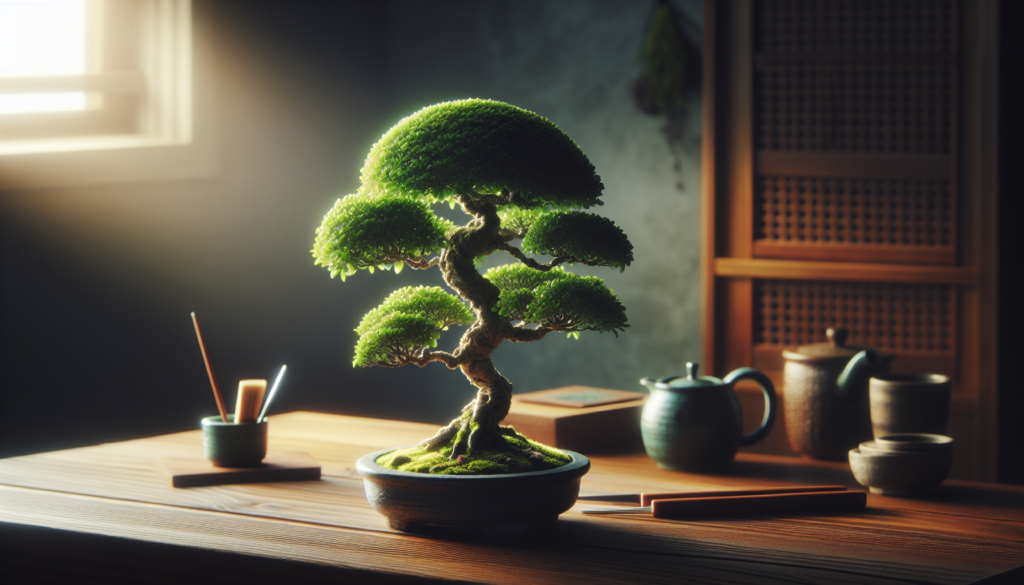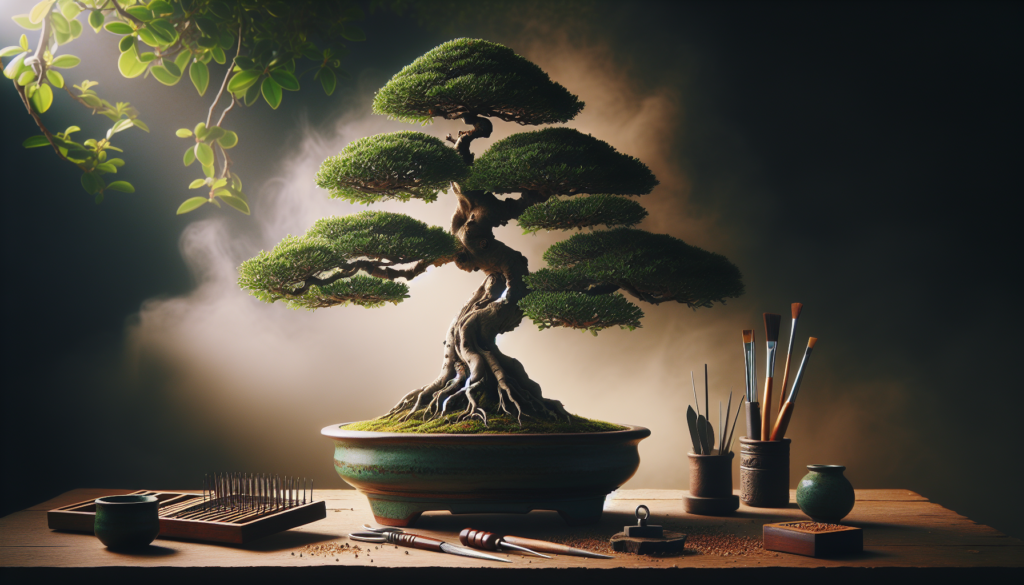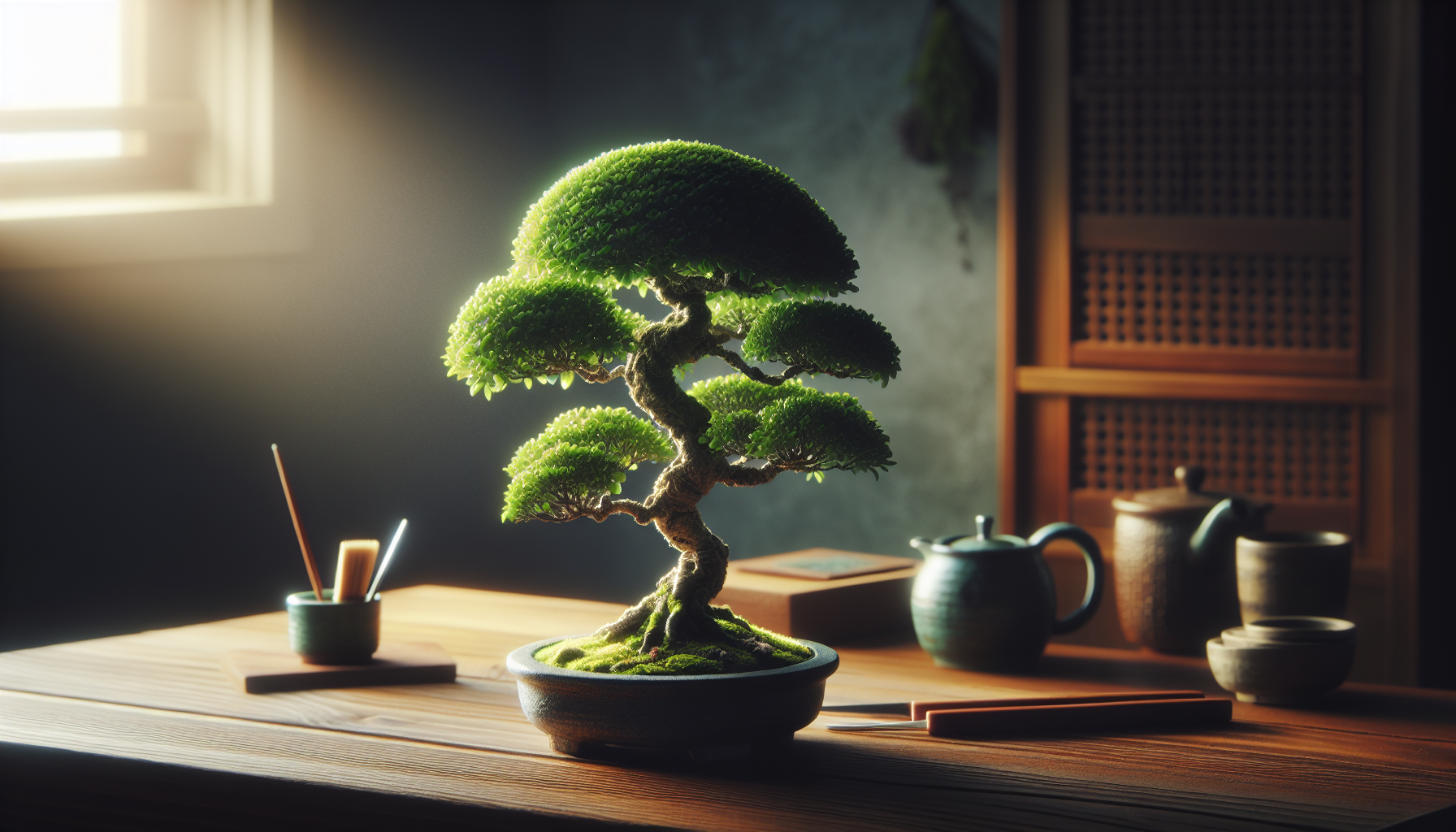So you’ve always admired those beautiful bonsai trees, but you’re worried about the hefty price tag that often comes along with them. Well, worry no more! In this article, you’ll discover a treasure trove of affordable tips that will teach you how to create your very own bonsai on a budget. Whether you’re a beginner or a seasoned gardener, these clever tricks and techniques will help you bring the art of bonsai into your life without breaking the bank. So get ready to roll up your sleeves and embark on a journey of creativity and serenity as you learn how to create a stunning bonsai masterpiece without spending a fortune.
Understanding the Basics of Bonsai
What is Bonsai?
Bonsai is a traditional Japanese art form that involves cultivating miniature trees in containers. The word “bonsai” itself means “tray planting,” and it is a unique way to create living works of art. Bonsai trees are carefully pruned and styled to mimic the shapes and forms of mature trees, resulting in a beautiful and visually appealing creation.
Historical Background
The art of bonsai originated in China over a thousand years ago and was later adopted by the Japanese. Initially, bonsai trees were only enjoyed by the elite and were considered a symbol of status and wealth. However, over time, bonsai gradually became more accessible to the general public, and today it is a popular hobby worldwide.
Types of Bonsai Trees
There are various types of bonsai trees to choose from, each with its own unique characteristics. Some popular varieties include the Juniper bonsai, which is known for its lush foliage and ability to withstand a wide range of climates; the Chinese Elm bonsai, which has delicate leaves and a beautiful bark; and the Japanese Maple bonsai, which displays vibrant colors during different seasons. It is essential to research and choose a bonsai tree suited for your environment and personal preferences.
Choosing the Right Tree for Your Budget
Most Affordable Bonsai Tree Varieties
If you are on a budget, there are several bonsai tree varieties that are more affordable than others. Some of these include the Ficus bonsai, which is relatively easy to care for and can be found at reasonable prices; the Jade bonsai, which is known for its resilience and striking foliage; and the Chinese Privet bonsai, which is also a budget-friendly option with its evergreen leaves and small white flowers. By selecting one of these varieties, you can enjoy the art of bonsai without breaking the bank.
Seasonal Considerations
When considering the cost of a bonsai tree, it is essential to take into account the seasons. Some varieties of bonsai may be more expensive during certain times of the year, such as during the blooming season. If you have a specific budget in mind, it may be wise to shop for bonsai trees outside of these peak seasons to find more affordable options.
Size and Age Factors
The size and age of a bonsai tree can also affect its price. Younger bonsai trees tend to be less expensive, as they have not yet developed the intricate characteristics of older specimens. Additionally, smaller bonsai trees are generally more affordable than larger ones, as they require less time and effort to cultivate. Consider these factors when choosing a bonsai tree to ensure it aligns with your budget constraints.

Purchasing Your Bonsai
Buying from a Nursery vs an Individual
When it comes to purchasing a bonsai tree, you have the option of buying from a nursery or an individual. Buying from a nursery can provide you with a wider selection of bonsai trees and the opportunity to seek advice from knowledgeable staff. On the other hand, buying from an individual, such as a bonsai enthusiast or a bonsai club member, can sometimes offer more personalized attention and the chance to find unique and rare specimens. Consider your preferences and budget when deciding where to purchase your bonsai tree.
Online Shopping Advantages and Disadvantages
Online shopping for bonsai trees can be a convenient and cost-effective option. There are numerous websites that offer a wide range of bonsai trees, allowing you to browse and compare prices from the comfort of your own home. However, it is important to exercise caution when purchasing online, as you may not have the opportunity to inspect the tree in person before buying. Make sure to read customer reviews, check the seller’s reputation, and inquire about their return policy to ensure a positive online shopping experience.
Bargain Hunting Tips
If you are looking for a budget-friendly option, consider visiting local garden centers, bonsai exhibitions, or even garage sales. These places often have discounted bonsai trees that may be slightly imperfect or in need of some extra care. With a little patience and TLC, you can transform these bargain finds into stunning bonsai creations without breaking the bank. Additionally, keep an eye out for sales and promotions at nurseries or online stores, as they can offer significant savings on bonsai trees.
Creating Your Own Bonsai from Seeds or Cuttings
Choosing Your Seeds or Cuttings
Creating a bonsai tree from seeds or cuttings can be a rewarding and budget-friendly way to start your own bonsai journey. When choosing seeds or cuttings, consider the type of bonsai tree you want to cultivate and the specific requirements for germination and growth. It is recommended to start with species that are known to be resilient and relatively easy to care for as a beginner.
Preparing the Seeds for Germination
Germinating bonsai seeds takes time and patience. To improve the chances of successful germination, it is essential to follow the specific requirements of the tree species you have chosen. This may involve scarification, stratification, or other seed treatment methods. Research the specific needs of your selected tree species and follow the recommended procedures to increase your chances of success.
Seedling Care
Once the seeds have germinated and seedlings have emerged, proper care is crucial to ensure their healthy growth. Provide adequate sunlight, water, and a suitable growing medium for the seedlings. As they grow, regular pruning and shaping will be necessary to train them into the desired bonsai form. Remember to be patient, as it takes several years for a bonsai tree to develop its desired characteristics.

Budget-Friendly Bonsai Soil
Understanding Bonsai Soil Requirements
Bonsai trees have unique soil requirements that differ from conventional houseplants or garden plants. Bonsai soil needs to be well-draining to prevent root rot and provide adequate oxygen to the tree’s roots. Additionally, it should retain enough moisture to sustain the tree between waterings. Understanding these requirements is crucial to ensure the health and vitality of your bonsai tree.
Creating Your Own Bonsai Soil Combination
Creating your own bonsai soil can be a cost-effective alternative to purchasing pre-packaged bonsai soil. A common bonsai soil mixture consists of a blend of organic matter (such as compost or sphagnum moss) and inorganic materials (such as crushed granite or pumice). The proportions of each component can vary depending on the species of bonsai tree and your specific climate. Experimentation and observation will help you find the optimal soil combination for your bonsai.
Cost-effective Soil Sources
There are various ways to source cost-effective materials for your bonsai soil. Local nurseries or garden centers may offer bulk discounts on soil components, especially if you buy in larger quantities. Alternatively, considering connecting with other bonsai enthusiasts in your area who may be willing to share or trade soil mixtures. Additionally, websites or forums dedicated to bonsai cultivation often have resources and recommendations for affordable soil options.
Economical Bonsai Pots
Understanding What Makes a Good Bonsai Pot
A bonsai pot is more than just a container for your tree; it is an integral part of the overall aesthetic and design. A good bonsai pot should complement the tree’s style and provide sufficient space for root growth while still maintaining a sense of proportion and balance. It is important to consider the material, size, and shape of the pot to ensure it is suitable for your bonsai tree.
Finding Affordable Bonsai Pots
Finding affordable bonsai pots can be a challenging task. One option is to search for discounted or clearance pots at garden centers or online stores. These pots may have small imperfections or be last season’s stock, but they can still serve their purpose effectively. Another option is to explore thrift stores or flea markets, where you may uncover unique and affordable pots with character. Remember to inspect the pots for any cracks or damage that may affect their functionality.
DIY Bonsai Pot Ideas
If you prefer a more creative and budget-friendly approach, consider making your own bonsai pot. There are numerous DIY bonsai pot ideas available online that utilize everyday objects such as ceramic bowls, wooden boxes, or even recycled containers. Engaging in a DIY project not only saves money but also allows you to add a personal touch to your bonsai display.
Bonsai Tree Maintenance on a Shoestring Budget
Proper Watering
Proper watering is essential for the health and longevity of your bonsai tree, and it can be done on a shoestring budget. Invest in a watering can or spray bottle, both of which can be purchased at an affordable price from gardening stores or online. Ensure that you water your bonsai tree consistently, taking into account its specific watering requirements. Overwatering or underwatering can lead to root rot or dehydration, respectively, so it is crucial to strike the right balance.
Pruning Your Bonsai Tree
Pruning is a vital aspect of bonsai tree maintenance, and it can be done without needing expensive tools. Invest in a pair of bonsai pruning shears or scissors, which are relatively affordable and essential for precision cuts. Regularly pruning your bonsai tree helps maintain its desired shape, remove excess foliage, and promote healthy growth. By learning proper pruning techniques and investing a little time, you can keep your bonsai tree in excellent condition without incurring significant costs.
Budget-Friendly Fertilizers
Fertilizing your bonsai tree provides it with the necessary nutrients for healthy growth, but it doesn’t have to be costly. There are various budget-friendly options available, such as organic fertilizers made from kitchen scraps or compost. Additionally, exploring homemade fertilizers or natural alternatives like fish emulsion or seaweed extract can be an affordable alternative to store-bought fertilizers. Properly researched and applied, these options can save you money while still providing the necessary nourishment for your bonsai tree.
Dealing with Pests and Diseases Economically
Common Bonsai Pests and Diseases
Like any living plant, bonsai trees can be susceptible to pests and diseases. Some common pests that may affect bonsai trees include aphids, spider mites, and scale insects, while diseases can range from root rot to fungal infections. Identifying and treating these issues promptly is vital to ensure the health and survival of your bonsai tree.
Preventative Measures
Taking preventative measures is the first line of defense against pests and diseases. Ensure that your bonsai tree is placed in an appropriate location with adequate sunlight and airflow, as proper environmental conditions can deter pests. Regularly inspect your tree for any signs of infestation or disease and take action immediately if anything is found. Keeping your bonsai tree healthy through proper watering, pruning, and fertilization can also strengthen its natural defenses against pests and diseases.
Affordable Treatment Solutions
If your bonsai tree does encounter pests or diseases, there are cost-effective treatment solutions available. Homemade remedies such as diluted dish soap solutions or neem oil sprays can be effective for certain pests. For fungal infections, pruning affected branches and applying a natural fungicide can help control the issue. It is essential to research and identify the specific pest or disease affecting your tree to find the most appropriate and affordable treatment option.
Budget-Friendly Bonsai Tree Styling Tips
Initial Shaping and Styling of Your Bonsai
The initial shaping and styling of a bonsai tree are crucial to establish its desired form. By using simple and affordable tools such as wire, bonsai wire cutters, and concave cutters, you can shape your bonsai tree into the desired style. Learning the proper wiring and pruning techniques is key to achieving the desired results without spending a fortune on expensive equipment or professional services.
Maintaining the Chosen Style
Once you have established the initial style of your bonsai tree, maintenance becomes essential to sustain its appearance. Regular pruning, wiring, and pinching of new growth are necessary to maintain the desired shape and form. By monitoring your bonsai tree’s growth and conducting necessary maintenance tasks on a regular basis, you can keep it looking its best without incurring excessive costs.
Styling Tools on a Budget
Investing in a few essential bonsai tools can effectively meet your styling needs without breaking the bank. Bonsai wire, wire cutters, and concave cutters are some of the basic tools required to shape and style your tree. These tools are widely available at affordable prices at garden centers or online. Starting with a few key tools, you can gradually build your collection as you gain experience and expand your bonsai skills.
Learning More about Bonsai without Breaking the Bank
Free Online Bonsai Resources
The internet is a treasure trove of free bonsai resources that can help you learn and expand your knowledge without spending any money. Online forums, websites, and social media groups dedicated to bonsai enthusiasts offer a wealth of information, tips, and advice. Additionally, video platforms and tutorials provide step-by-step guidance on various bonsai techniques. By exploring these free online resources, you can enhance your bonsai skills and continue to develop your passion for this ancient art form.
Library Resources
Public libraries offer a vast collection of books and magazines dedicated to bonsai that can be borrowed for free. These resources provide detailed information on bonsai history, cultivation techniques, styling ideas, and more. By utilizing your local library, you can access valuable references and gain insights from experienced bonsai artists without spending money on expensive books or subscriptions.
Local Bonsai Club Membership
Joining a local bonsai club can be an excellent way to connect with fellow enthusiasts and gain hands-on experience without a hefty price tag. Bonsai clubs often organize workshops, demonstrations, and field trips where members can learn from experienced bonsai practitioners. By becoming a member, you not only expand your knowledge but also gain access to valuable resources and support from the bonsai community in your area.
In conclusion, creating a bonsai on a budget is not only possible but also an art form that can be enjoyed by anyone. By understanding the basics of bonsai, choosing the right tree for your budget, being resourceful in the purchasing process, creating your own bonsai from seeds or cuttings, and implementing cost-effective soil, pot, and maintenance strategies, you can embrace the beauty of bonsai without breaking the bank. With a friendly attitude and a willingness to learn, you can cultivate and maintain your bonsai tree while enjoying the art and tranquility it brings to your life.








